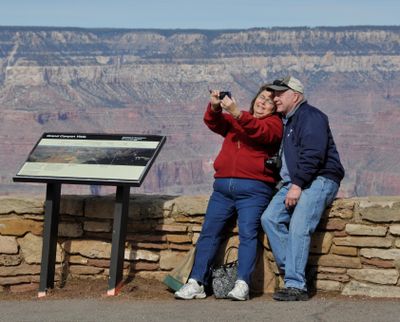‘Safe Selfie’ policy adopted at Yellowstone National Park

In response to an epidemic of foolish, irresponsible and sometimes illegal behavior over the last two record-setting years of attendance, Yellowstone National Park officials are asking 2017 visitors to “Take the Yellowstone Pledge.”
Or, for short-hand, as it is also being called, adopting a “Safe Selfie” policy.
“It stems from negative behavior,” said Yellowstone public affairs specialist Morgan Warthin. “People are getting way too close to wildlife.”
The practice of self-portraiture has been linked to safety issues and accidents in other parks, too, including Grand Canyon.
Although visitors may not be asked to fill out a form or swear on a Bible to uphold the precepts of the new pledge, they will be made aware of it.
During the last two years, as Yellowstone broke records by topping 4 million tourists for the first time in 2015 and then topped that with 4.2 million visitors last year, numerous incidents born of recklessness have caused outrage and consternation, injuries and even deaths.
In many cases, despite written warnings, posted signs and ranger advice, people have ignored rules.
Two summers ago five people taking selfie photographs provoked bison into attacking them. No one was killed, but medical treatment was needed.
Last year a tourist died after walking off a pedestrian boardwalk into a thermal area, a group of Canadian adventurers tramped around in the Grand Prismatic Spring, then publicized it. That wanton activity led to prosecution and fines. Also, two men loaded a bison calf into their vehicle to save it from the cold, only to see the calf killed after its herd rejected it.
Most of these incidents were highly publicized, in some cases garnering international attention.
The pledge is a way to raise awareness, Warthin said. The multi-point verbal pledge stresses safety under the umbrella of the theme “Take the pledge. Tell a friend. Protect the park.”
Yellowstone is calling the pledge “a personal promise you can make to yourself and the park.”
It reads, “To be a steward and help protect myself and the park, I pledge to …”
What follows is a checklist of good behavior habits for visitors, including staying on the boardwalks in thermal areas, not throwing things into the hot springs, parking in the right places, staying with the car if stuck in wildlife jams, keeping food away from animals, following speed limits, traveling safely, recycling and calling 911 to report violations.
Plus, staying an appropriate distance from wildlife to “practice safe selfies.”
The safe selfies pledge is about saving people from themselves through prudent behavior. Too often visitors “look at the Park as a zoo. It’s a wild area, but it’s not a zoo,” Warthin said.
Field workers report virtually all male grizzlies have come out of their dens and are on the prowl.
Last year was the 100th anniversary of the National Park Service and nationwide advertising urged Americans to visit their parks. They did so in record numbers, not just at Yellowstone, and officials do not expect any reduction in attendance this year.
“We anticipate visitation to either continue to increase or remain at the 4.2-million level,” Warthin said.
What officials would love to see is a decline in unnecessary manmade incidents that carry large risks.
“I’m so hopeful this year it’s going to be all good,” Warthin said.